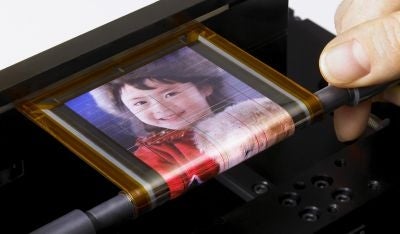Electronics giant develops first "rollable" video screen

Sony Corp. has developed what it claims is the first video screen that is sufficiently flexible to be rolled around a pencil.
The Japanese home electronics giant has managed to construct what it describes as a super-flexible, 80-micrometer thick screen that uses high-performance organic thin-film transistors (ORFTs). The prototype full-color screen may only measure 4.1 inches at present, but the company has high hopes that the technology will take off in the same way as 3D television technology has boomed recently.
Other companies and research organizations are working on similar projects, notably NHK, Japan's national broadcaster, and the government-run New Energy and Industrial Technology Development Organisation, although Sony appears to be heading the pack for commercialization of the product.
To create the Organic Light Emitting Display (OLED), Sony developed transistors with a new organic semiconductor material that has eight times the current modulation of conventional OTFTs.
Repeated tests have shown that the panel is capable "of reproducing moving images while being repeatedly rolled up - around a cylinder with a radius of 4 mm - and stretched," the company said in a statement.
"Even after 1,000 cycles of repeatedly rolling up and stretching the display, there was no clear degradation in the display's ability to reproduce moving images," the company said.
In the future, the technology could be applied to a whole range of flexible mobile devices, including home-use televisions, screens for industrial applications and electronic newspapers, books or magazines that can be rolled up and popped in the user's pocket.
Sony will unveil the prototype screen on Thursday (May 27) on the penultimate day of the Society for Information Display's international symposium in Seattle, Washington.
JR
Join our commenting forum
Join thought-provoking conversations, follow other Independent readers and see their replies
Comments
Bookmark popover
Removed from bookmarks